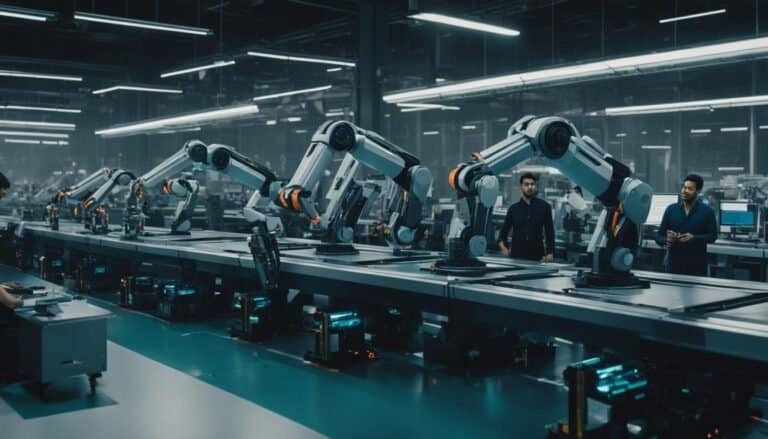AI in Manufacturing
In the intricate dance of gears and cogs on the manufacturing floor, AI emerges as the unseen conductor orchestrating a symphony of efficiency and precision.
Imagine a world where machines predict faults before they occur, ensuring seamless operations and reducing downtime to a minimum.
Curious to explore how AI can revolutionize quality control, streamline production planning, and optimize supply chains in ways you never imagined? The possibilities are endless, and the impact on manufacturing is profound.
Key Takeaways
- Predictive maintenance and quality control optimize production efficiency.
- AI-driven systems enhance operational efficiency and productivity.
- Robotics integration and real-time data utilization improve manufacturing processes.
- Employee training and innovative strategies boost adaptability and efficiency.
Predictive Maintenance
Predictive maintenance utilizes advanced algorithms to anticipate equipment failures before they occur, optimizing production efficiency and reducing downtime. By leveraging machine learning algorithms, manufacturers can analyze historical data to predict when maintenance is required, preventing unexpected breakdowns. One key aspect of predictive maintenance is sensor data integration. Sensors embedded within machinery collect real-time data on various parameters such as temperature, vibration, and performance metrics. This data is then fed into the machine learning algorithms, which identify patterns indicative of potential issues. Through continuous monitoring and analysis of sensor data, manufacturers can schedule maintenance activities during planned downtime, ensuring that equipment operates at peak performance levels.
Machine learning algorithms play a crucial role in predictive maintenance by enabling predictive analytics. These algorithms learn from past data patterns to forecast when equipment is likely to fail, allowing for timely interventions. By combining historical data with live sensor information, manufacturers can move from reactive or scheduled maintenance to a more efficient predictive maintenance strategy. This proactive approach not only reduces overall maintenance costs but also minimizes unplanned downtime, ultimately leading to increased productivity and improved operational efficiency. In conclusion, the integration of machine learning algorithms and sensor data in predictive maintenance is revolutionizing the manufacturing industry by enabling predictive and preemptive maintenance strategies.
Quality Control
You're about to explore how AI enhances quality control in manufacturing through defect detection algorithms, automated inspection processes, and real-time quality monitoring.
These advanced systems allow for precise identification of defects, streamline inspection tasks, and provide instantaneous feedback on product quality.
The integration of AI in quality control processes is revolutionizing manufacturing standards by ensuring higher accuracy and efficiency in production lines.
Defect Detection Algorithms
Utilizing advanced algorithms, defect detection in manufacturing processes plays a crucial role in ensuring product quality and minimizing production waste. Anomaly detection algorithms and machine learning models are at the forefront of defect detection, enabling manufacturers to identify and rectify issues swiftly. These algorithms analyze vast amounts of data from production lines, pinpointing deviations from the norm that could indicate defects. By implementing these sophisticated technologies, manufacturers can proactively address quality issues, reduce the likelihood of faulty products reaching the market, and enhance overall operational efficiency. The table below provides a snapshot of key features of defect detection algorithms:
| Algorithm Type | Key Functionality |
|---|---|
| Anomaly Detection | Identifies deviations from normal patterns |
| Machine Learning Models | Utilizes historical data for predictive defect analysis |
Automated Inspection Processes
Automated inspection processes in manufacturing, particularly in quality control, streamline production by leveraging cutting-edge technologies for enhanced efficiency and precision. These processes utilize automated inspection techniques that involve the use of machine learning algorithms to detect defects and ensure product quality.
By employing advanced algorithms, manufacturers can automatically inspect components, identify imperfections, and make real-time decisions to maintain high standards. Machine learning algorithms play a crucial role in analyzing large datasets quickly and accurately, enabling rapid identification of potential issues in the production line.
This proactive approach not only enhances the overall quality control process but also minimizes the likelihood of defects reaching the end consumer, ultimately improving customer satisfaction and brand reputation.
Real-Time Quality Monitoring
Efficient real-time quality monitoring systems play a pivotal role in ensuring optimal quality control in manufacturing processes. By leveraging machine learning algorithms and image recognition technology, manufacturers can detect defects or deviations from standards instantly.
Machine learning algorithms analyze data from sensors and production equipment in real-time, identifying patterns that indicate potential quality issues. Image recognition technology enables automated inspection of products, comparing them to predefined quality criteria with precision.
These technologies allow for quick decision-making, reducing the likelihood of defective products reaching the market. Real-time quality monitoring not only enhances product quality but also increases operational efficiency by minimizing rework and waste.
Implementing these advanced systems is crucial for maintaining high-quality standards in modern manufacturing environments.
Supply Chain Optimization
To enhance manufacturing processes, optimizing supply chains is imperative for maximizing efficiency and reducing costs. When it comes to lead time optimization, AI plays a crucial role in predicting demand patterns, streamlining production schedules, and ensuring timely delivery of materials. Additionally, fostering supplier collaboration through AI-driven platforms facilitates seamless communication, enhances transparency, and builds stronger relationships within the supply chain network.
Implementing AI in supply chain optimization offers a plethora of benefits, ranging from inventory management to demand forecasting. By leveraging AI algorithms, you can analyze historical data to predict future demand more accurately, thereby reducing excess inventory and minimizing stockouts. Moreover, AI enables real-time monitoring of supplier performance, allowing you to identify potential bottlenecks or delays before they escalate.
Let's delve into a comparative analysis of traditional supply chain management versus AI-driven supply chain optimization:
| Aspect | Traditional SCM | AI-driven SCM |
|---|---|---|
| Demand Forecasting | Relies heavily on historical data and manual analysis. | Utilizes advanced algorithms for precise demand predictions. |
| Inventory Management | Often leads to overstocking or stockouts due to inaccurate forecasts. | Enables proactive inventory adjustments based on real-time data. |
| Supplier Collaboration | Communication is typically fragmented, leading to delays and errors. | Facilitates seamless communication and enhances transparency. |
Production Planning
Maximizing efficiency in manufacturing processes requires strategic production planning to optimize resource utilization and meet demand effectively. In the realm of production planning, capacity planning and production scheduling play pivotal roles in ensuring operations run smoothly and productively.
- Capacity Planning:
- Forecast demand accurately to determine the required capacity.
- Evaluate current capacity constraints and identify areas for improvement.
- Utilize historical data and predictive analytics to enhance capacity planning accuracy.
- Implement flexible strategies to adjust capacity based on changing demand patterns.
Effective production scheduling is imperative for maintaining workflow efficiency and meeting deadlines. By utilizing advanced algorithms and AI technologies, manufacturers can create optimized schedules that consider various constraints and objectives simultaneously. Such systems can automatically adjust schedules in real-time based on changing priorities, machine availability, or unexpected disruptions.
Inventory Management
You can enhance your manufacturing operations by implementing AI-driven solutions for inventory management.
Real-time inventory tracking enables you to monitor stock levels accurately, while automated stock replenishment ensures timely restocking to prevent shortages.
Additionally, predictive maintenance alerts help you address issues proactively, optimizing efficiency and minimizing production disruptions.
Real-Time Inventory Tracking
Implementing real-time inventory tracking enhances operational efficiency and streamlines inventory management processes in manufacturing. This technology allows you to track inventory levels accurately and make informed decisions promptly. Here are key benefits of real-time inventory tracking:
- Enhanced Visibility: Gain real-time insights into stock levels, locations, and movement.
- Improved Accuracy: Minimize errors and discrepancies in inventory records.
- Optimized Reordering: Automatically trigger reorders based on preset thresholds.
- Efficient Resource Allocation: Allocate resources effectively by knowing what inventory is available and where.
Automated Stock Replenishment
To streamline inventory management further, consider implementing automated stock replenishment, a crucial aspect of efficient inventory management in manufacturing. Automated stock replenishment utilizes machine learning algorithms to predict demand accurately and automate the process of restocking inventory.
By analyzing historical data and current trends, these algorithms can optimize inventory levels, reducing the risk of stockouts or excess inventory. This proactive approach not only ensures that materials are always available when needed but also minimizes holding costs and maximizes warehouse space utilization.
Inventory optimization through automated stock replenishment not only enhances operational efficiency but also contributes to cost savings and improved customer satisfaction. Embracing this technology can revolutionize the way manufacturers manage their inventory processes.
Predictive Maintenance Alerts
Utilizing predictive maintenance alerts in inventory management enhances operational efficiency and reduces downtime in manufacturing facilities. Machine learning applications analyze historical data to predict equipment failures before they occur, aiding in proactive maintenance scheduling.
Sensor data analysis helps monitor machinery health in real-time, enabling the detection of anomalies that could lead to breakdowns. This proactive approach minimizes unexpected downtime and prevents costly production interruptions.
Process Automation
Automated processes in manufacturing enhance efficiency and productivity. By implementing process automation through AI technologies, companies can streamline operations, reduce errors, and increase output. Process optimization is a key aspect of automation, where machine learning algorithms analyze data to identify patterns and make real-time adjustments, leading to improved overall efficiency.
To further illustrate the benefits of process automation, consider the following table:
| Automation Benefits | Description |
|---|---|
| Efficiency Enhancement | Automated workflows and tasks can be completed faster and with fewer resources. |
| Productivity Boost | By automating repetitive processes, employees can focus on more strategic tasks. |
| Cost Reduction | Reduced manual intervention leads to lower operational costs and increased savings. |
| Quality Improvement | Automation helps maintain consistent quality standards throughout the production. |
Efficiency enhancement is a primary goal of cognitive computing in manufacturing. This involves the use of AI systems that mimic human thought processes to automate complex decision-making tasks. By integrating cognitive computing into automation processes, manufacturers can achieve higher levels of operational efficiency and adaptability.
Defect Detection
Defect detection plays a crucial role in ensuring product quality and minimizing manufacturing errors. It's essential to leverage AI technologies for efficient anomaly detection and defect classification. AI systems can significantly enhance the defect detection process by analyzing vast amounts of data in real-time and identifying even the slightest deviations from the standard quality parameters.
- Real-time Monitoring: AI enables real-time monitoring of the manufacturing process, allowing for immediate detection and classification of defects as they occur.
- Enhanced Accuracy: By utilizing machine learning algorithms, AI systems can achieve higher accuracy rates in defect classification compared to traditional methods.
- Predictive Maintenance: AI can predict potential defects before they occur by analyzing historical data patterns, enabling proactive maintenance to prevent manufacturing errors.
- Continuous Improvement: Through constant learning and adaptation, AI systems can continuously improve defect detection algorithms, leading to more efficient and effective quality control processes.
Energy Efficiency
To optimize manufacturing processes further, focus on improving energy efficiency through AI-powered solutions that streamline resource utilization and reduce operational costs. By implementing AI technologies for energy consumption analysis, manufacturers can identify areas of high energy usage, pinpoint inefficiencies, and make data-driven decisions to enhance sustainability initiatives.
AI systems can continuously monitor energy consumption patterns in manufacturing facilities, detecting fluctuations and anomalies that may indicate wastage or inefficiencies. These systems can analyze vast amounts of data in real-time, providing insights into when and where energy is being used most intensively. By leveraging this information, manufacturers can adjust operations to optimize energy usage, reduce costs, and minimize environmental impact.
Moreover, AI algorithms can predict energy consumption based on production schedules, external factors, and historical data. This predictive capability enables proactive energy management, allowing manufacturers to plan ahead, allocate resources efficiently, and meet sustainability goals. By integrating AI-driven energy efficiency solutions into manufacturing processes, companies can't only reduce their carbon footprint but also enhance their competitiveness in an increasingly environmentally conscious market.
Asset Management
Efficiently managing assets in manufacturing operations is crucial for optimizing productivity and minimizing downtime. In today's competitive manufacturing landscape, leveraging asset management strategies is essential to ensure smooth operations and cost-effectiveness. Here are some key points to consider when focusing on asset management:
- Asset Utilization: Tracking and analyzing how effectively assets are being utilized within your manufacturing processes can provide valuable insights into areas that require improvement. By optimizing asset utilization, you can enhance overall productivity and reduce waste.
- Maintenance Scheduling: Implementing a proactive maintenance schedule based on data-driven insights and predictive analytics can help prevent unplanned downtime. This approach ensures that assets are well-maintained, leading to increased reliability and operational efficiency.
- Inventory Management: Efficiently managing inventory levels and tracking assets in real-time can streamline production processes and reduce lead times. Adopting automated inventory tracking systems can optimize asset utilization and minimize stockouts.
- Asset Performance Monitoring: Continuous monitoring of asset performance metrics allows for early detection of potential issues, enabling proactive maintenance interventions. By monitoring key performance indicators, you can enhance asset reliability and extend their lifespan.
Robotics Integration
Integrating robotics into manufacturing processes revolutionizes efficiency and productivity. When it comes to robotic programming efficiency, advancements have streamlined the way robots are programmed, reducing setup times and improving overall production output. Modern robotic systems offer intuitive interfaces that allow for quick reprogramming, minimizing downtime during transitions between different tasks.
Human-robot collaboration techniques have also played a significant role in enhancing manufacturing operations. Collaborative robots, or cobots, are designed to work alongside human operators, performing repetitive or physically strenuous tasks. This synergy between humans and robots not only increases efficiency but also ensures a safer working environment. Through the implementation of sensors and intelligent algorithms, these robots can adapt to the presence of humans, adjusting their speed and force to prevent accidents.
Furthermore, the integration of robotics has enabled manufacturers to achieve higher levels of precision and consistency in their processes. Robots excel at repetitive tasks that demand a high degree of accuracy, reducing errors and waste in production lines. By leveraging human-robot collaboration techniques, companies can optimize their workflow, reallocating resources to more complex or strategic activities that require human expertise. As technology continues to evolve, the synergy between humans and robots will undoubtedly drive further enhancements in manufacturing efficiency and productivity.
Safety Monitoring
You need to consider implementing real-time hazard detection systems, automated emergency response mechanisms, and worker injury prevention protocols in your manufacturing processes to enhance safety monitoring.
These AI-driven technologies can swiftly identify potential dangers, trigger immediate responses in critical situations, and proactively prevent accidents, ensuring a safer work environment for all personnel involved.
Real-Time Hazard Detection
Real-time hazard detection systems in manufacturing plants continuously monitor for potential safety risks to ensure a secure working environment. These systems play a crucial role in safeguarding employees and preventing accidents by promptly identifying and addressing hazards.
Key aspects of real-time hazard detection include:
- Immediate alert notifications to relevant personnel.
- Integration with automated shutdown mechanisms for swift action.
- Continuous monitoring of equipment and processes for anomalies.
- Data-driven analysis to predict and prevent potential hazards.
Automated Emergency Response
In a manufacturing setting, ensuring swift and automated emergency responses is paramount for maintaining a safe working environment. Emergency response coordination and incident response training are crucial components in this process. By leveraging AI technologies, manufacturers can enhance their emergency response systems to react promptly to any potential hazards. Automated alerts and notifications can be triggered by AI systems when anomalies or emergencies are detected, enabling a rapid and coordinated response from the appropriate personnel. Implementing automated emergency response systems not only improves overall safety but also minimizes the response time in critical situations. Ensuring that all employees are well-versed in incident response protocols through regular training sessions further strengthens the effectiveness of automated emergency response measures.
| Benefits of Automated Emergency Response | ||
|---|---|---|
| Swift Response | Automated Alerts | Coordinated Actions |
| Minimized Downtime | Improved Safety Measures | Enhanced Employee Safety Training |
Worker Injury Prevention
To enhance worker safety and prevent injuries in manufacturing environments, implementing robust safety monitoring systems is imperative. Utilizing ergonomic design and wearable technology can significantly reduce the risk of work-related injuries. Behavior-based safety programs play a crucial role in fostering a safety-conscious culture among employees. Conducting regular risk assessments helps identify potential hazards and allows for proactive measures to mitigate risks before accidents occur.
- Ergonomic Design: Ensuring workstations and tools are designed for optimal human use.
- Wearable Technology: Utilizing devices that monitor workers' movements and provide real-time feedback.
- Behavior-Based Safety: Encouraging safe behaviors through training and incentives.
- Risk Assessment: Identifying and addressing potential hazards to prevent accidents.
Demand Forecasting
When implementing AI in manufacturing processes, accurate demand forecasting is crucial for optimizing production efficiency and minimizing costs. Production forecasting leverages machine learning algorithms to analyze historical data, market trends, and other relevant factors to predict future demand accurately. By utilizing machine learning models, manufacturers can make data-driven decisions that lead to more efficient resource allocation and reduced inventory holding costs.
Market trends play a vital role in demand forecasting. Through advanced data analytics, AI systems can parse through vast amounts of market data in real-time to identify patterns and fluctuations that impact demand. This allows manufacturers to adjust production levels promptly in response to changing market conditions, ensuring that supply meets demand without excess inventory or stockouts.
AI-driven demand forecasting not only helps in streamlining production processes but also enables manufacturers to stay competitive in dynamic markets. By accurately predicting demand, companies can optimize their supply chain management, improve customer satisfaction through timely deliveries, and ultimately increase profitability. The integration of AI technologies in demand forecasting empowers manufacturers to make proactive decisions based on data-driven insights, leading to more agile and efficient operations.
Workflow Optimization
Demand forecasting lays the foundation for optimizing production efficiency; now, let's focus on streamlining your manufacturing processes further through workflow optimization. When it comes to maximizing process efficiency, implementing workflow optimization strategies is crucial. By fine-tuning the flow of tasks and resources, you can eliminate bottlenecks, reduce wastage, and enhance overall productivity within your manufacturing operations.
Key Strategies for Workflow Optimization:
- Automate Repetitive Tasks: Integrate automation technologies to handle routine processes, freeing up human resources for more complex and critical activities.
- Implement Lean Principles: Apply lean manufacturing principles to identify and eliminate non-value-added activities, ensuring that every step in your workflow contributes to the final output.
- Utilize Real-Time Data: Leverage IoT devices and sensors to gather real-time data on production processes, enabling quick decision-making and adjustments to optimize workflow efficiency.
- Cross-Train Employees: Develop a versatile workforce by providing training across different tasks, allowing for flexibility in task allocation and smoother workflow transitions.
Root Cause Analysis
Root Cause Analysis uncovers the fundamental issues behind operational inefficiencies in manufacturing processes. By employing root cause analysis techniques, manufacturers can delve deep into the underlying factors contributing to defects, downtime, or quality issues. This method goes beyond addressing surface problems, aiming to eradicate issues at their core.
In the realm of AI in manufacturing, machine learning algorithms play a pivotal role in enhancing root cause analysis. These algorithms can sift through vast amounts of data to identify patterns, anomalies, and correlations that mightn't be apparent through traditional analysis methods. By leveraging machine learning, manufacturers can streamline the root cause analysis process, making it more accurate and efficient.
One prominent benefit of utilizing machine learning algorithms for root cause analysis is the ability to predict potential issues before they occur. By analyzing historical data and real-time inputs, these algorithms can forecast potential problems, allowing manufacturers to take proactive measures to prevent them.
Performance Monitoring
You should focus on real-time data analysis and predictive maintenance alerts when considering performance monitoring in manufacturing. These aspects are crucial for providing insights into machine efficiency and potential issues before they arise.
Real-Time Data Analysis
Real-time data analysis in manufacturing enables immediate monitoring and assessment of performance metrics to drive operational efficiency. Leveraging machine learning algorithms enhances production efficiency, while data visualization aids in process optimization.
To effectively utilize real-time data analysis:
- Implement predictive analytics to anticipate production issues before they occur.
- Utilize anomaly detection to quickly identify irregularities in the manufacturing process.
- Integrate automated alerts to notify key personnel of critical performance deviations.
- Enable real-time tracking of key performance indicators to make data-driven decisions swiftly.
Predictive Maintenance Alerts
Enhancing manufacturing operations, predictive maintenance alerts provide proactive performance monitoring to prevent downtime and optimize equipment efficiency. By utilizing machine learning algorithms and sensor data analysis, these alerts can predict potential equipment failures before they occur.
Machine learning algorithms analyze historical data to identify patterns and anomalies, enabling the system to forecast when maintenance is needed. Sensor data analysis plays a crucial role in this process, as it continuously monitors equipment performance in real-time, detecting any deviations from normal operating conditions.
This proactive approach not only saves costs associated with unexpected downtime but also extends the lifespan of machinery by addressing issues before they escalate. Implementing predictive maintenance alerts is a strategic investment that enhances overall operational efficiency and productivity.
Conclusion
In conclusion, AI in manufacturing has proven to be a game-changer, with predictive maintenance reducing downtime by up to 50%.
By utilizing advanced algorithms and data analytics, companies have been able to optimize their production processes, improve quality control, and streamline supply chain operations.
The ability of AI to analyze vast amounts of data in real-time has revolutionized the industry, leading to increased efficiency and profitability.
Embracing AI technology is essential for staying competitive in today's fast-paced manufacturing landscape.







